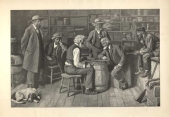The Checker Maven
The World's Most Widely Read Checkers and Draughts Publication
Bob Newell, Editor-in-Chief
Published every Saturday morning in Honolulu, Hawai`i
Noticing missing images? An explanation is here.
A May Day Problem
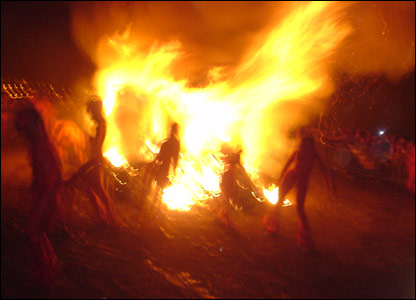
May Day, the first of May, has its presumable roots in the ancient fires of Beltane, but is today celebrated in a number of different ways. In England, May Day is a substantial civic celebration, with traditions such as the Maypole, the May Queen, and much more.

In France, it's customary to give a lilly-of-the-valley to your lady of choice.

In Germany, Walpurgisnacht is celebrated on May Day Eve (Faust, anyone?).

May Day is also a Roman Catholic holiday. And finally, May Day is celebrated by the international labor movement as a day of the worker, and in some countries, military parades are held.

While we don't in any way accord with the philosophies of these aforesaid countries, most of whom repressed and exploited the worker while pretending to act in his interests, we think a checker problem that Tom Wiswell originally called "Victory" is appropriate. On May Day, the ancient traditions celebrated the victory of light over darkness, with the advent of spring and the coming of longer days. And we note that in the end, when the Communist system collapsed some years ago, the worker really was the victor---1.
So here's our celebratory problem, and as usual for a Tom Wiswell piece, it's a dandy. It's anything but easy, but it's worth the effort.
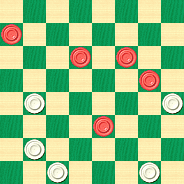
WHITE
White to Play and Win
W:W17,20,25,30,32:B5,10,11,16,23.
1---The Checker Maven makes no apologies for its pro-democracy position.
March on to victory, but if it rains on your parade, click Read More to see the delightful solution.![]()
Hynd's Hedgehopper

The Hedgehoppers were a relatively obscure band from Durban, South Africa, circa 1971 (just where do we come up with these things?). Quite honestly, we've never listened to their music; and today, we'd wager it would be difficult to find.
Perhaps equally difficult to find is Willie Ryan's classic book, Tricks Traps & Shots of the Checkerboard. Fortunately, we're reprinting sections of it here each month; and in our usual manner, our lead photo and full column have related titles. Today, we bring you Hynd's Hedgehopper, explained to us by Willie himself.
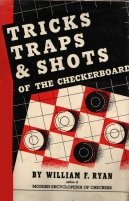
"Here is a good stroke by Champion John Hynd of Manchester, England, which is recorded in every expert's notebook. Hynd, by the way, has been playing top-flight draughts for almost half a century, and is still playing with the best. A former Champion of England, he played on the British team in the 1905 International Match.
| 10-14 | 28-24 | 9-14 |
| 24-20 | 4-8 | 26-23 |
| 6-10 | 23-19 | 2-6 |
| 22-18 | 8-11 | 30-26 |
| 11-15 | 25-22 | 5-9---A |
| 18-11 | 14-18 | See the |
| 8-15 | 29-25 | diagram. |

WHITE
White to Play and Win
W:W19,20,21,22,23,24,25,26,27,31,32:B1,3,6,7,9,10,11,12,14,15,18.
A---Off the beam, and loses. Here is how black should play it: 6-9*, 32-28, 9-13---1, 19-16, 12-19, 23-16, 14-17, 21-14, 10-17, 24-19, 15-24, 22-8, 3-19, 27-23, 17-21, 23-16, 21-30, 28-19, 30-23, 16-12, 23-16, 20-2, 1-6, etc., for a draw; an old combination."
1---Ed Gilbert's King's Row computer engine gives 1-6 to draw here as well, and the continuation is also quite flashy: 1-6 20-16 11x20 19-16 12x19 23x16 15-19 24x15 10x19 22x15 14-18 15-11 18-23 27x18 9-13 11x2 3-8 2x9 5x30 to a draw.
Can you sing and dance your way through this one? Don't worry, sweet music can be had by clicking on Read More, which will take you straight to the solution.![]()
Our New Santa Fe Offices

We've had a few inquiries about our new, downsized and down-costed Santa Fe location, so to better illustrate, we've shown above a (rather poor) webcam photo of your editor's desk. The offices are not much different from those at the old location; they're just smaller and the building itself is somewhat older, and certainly in a part of town substantially further down the prestige ladder. What a difference a half a mile can make!
The larger question, of course, is as yet unanswered: in this economic downturn, how long can we keep offices in both Santa Fe and Honolulu? While we don't yet have a timetable, it seems likely that one or the other will close in the next year or so. Time, fortune, and the wishes of our parent company, Mr. Fred Investments, will ultimately tell the tale.![]()
Heffner and Price

Volleyball players Heffner and Price were two of the mainstays of the Alabama women's volleyball team some six or seven years ago, but that was Erin Heffner and Erin Price. And for better or worse, our topic in these columns isn't women's volleyball.
Instead, it's our mission and our duty to focus on checkers, and today's lesson in our monthly Checker School series, drawn from the pages of Ben Boland's Famous Positions in the Game of Checkers, concerns closely related positions by checkerists A. J. Heffner and G. Price. We have no way of knowing if these gentlemen ever played volleyball, but their mastery of the art of Dama is undoubted.
BLACK
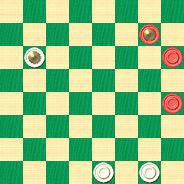
WHITE
White to Play and Win
W:WK9,31,32:BK8,12,20.
WHITE
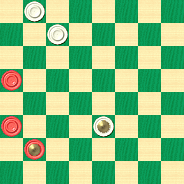
BLACK
Black to Play and Draw
B:W32,27,K10:B20,12,K8.
Now that we've served up these problems, can you volley back at us with the solutions? Give it a try, but if there are spikes in your path, click on Read More to jump to the solutions, sample game, and explanatory notes.![]()
Two Parts from Denvir

We're not talking today about the city of Denver, as attractive and appealing as that modern metropolis might be. Instead, we're talking about John Denvir (and neither do we mean the late popular musician who called himself John Denver). John T. Denvir was a well-known checker player and author in the early 1900s, and was, to put it mildly, a man of controversy. He did publish a number of checker instruction books, and today's two-part problem is drawn from one of them.
First, look at this position arising from a Single Corner opening:
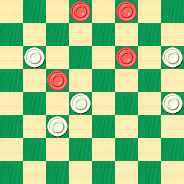
WHITE
White to Play and Draw
W:W22,20,18,12,9:B14,11,3,2.
White has drawing moves here, and it's not so hard to find them. We invite you to give it a try.
One way not to draw is with the seemingly clever 20-16, which results in this position.
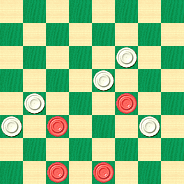
BLACK
Black to Play and Win
B:W22,18,16,12,9:B14,11,3,2.
Can you find a win for Black at this point?
If you don't find the solutions, you needn't travel all the way to Denver to see how it's done; clicking on Read More will transport you immediately to the answers.![]()
Downsizing

The current state of the economy affects everyone, and The Checker Maven is no exception.
We don't spoil your reading experience by publishing advertising; we will never, ever charge a subscription fee; and we neither solicit nor accept donations. Revenue from a handful of collateral products, and cross-subsidies from our parent company, the Avi Gobbler Productions Division of Mr. Fred Investments, provide us with our only sources of income. It's no surprise that with the economy as it is, our operating funds are down substantially.
So, as a cost-saving measure, we made the decision to move our Santa Fe offices half a mile or so to smaller quarters in a less expensive area. Our staff count will remain the same, and most importantly, regular Saturday publication of The Checker Maven will continue without interruption or reduction in quality or quantity of content.![]()
Springing Into Spring

Spring has come to the northern hemisphere, and our rather impressive long jumper in the photo above is literally springing into spring as the outdoor season arrives. But even with our irrepressible urge to get out of the house and into the fine fresh air, we know you still have a little time to keep up with your game of checkers.
In this week's column we help you do just that, with a nice speed problem that will give you a little practice without keeping you inside for too long. We rank it as "medium" on the difficulty scale and allow you ... one minute. After all, the sunshine and blue skies are calling you!
Click below to show the problem and start the clock, then click on Read More to check your solution.
April Speed Problem (medium; 60 seconds)
![]()
Double Crossing

A very complex-looking double crossing is to be found in the model railway section pictured above. We wonder, though, if it's equal in complexity to today's checker problem, which, most appropriately, arises in a line of the Double Cross opening. The Double Cross, arising from 9-14 23-18, has a bit of shall we say a checkered reputation, with 23-18 being at best a weak reply to 9-14. Nevertheless, it's completely playable if you know what you're doing, but there's plenty of opportunity to go astray.
But for now, let's jump right into our position, in which White has indeed strayed from the narrow path.
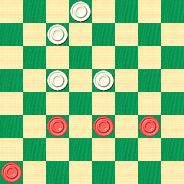
BLACK
Black to Play and Win
B:W31,27,19,18:B11,10,9,4.
Can you find the Black win, or will you get all crossed up? Don't be cross about it; clicking on Read More brings you the solution, the run-up to the position, and the usual explanatory notes.![]()
Ferrie's Flourish

Fed by the clear, clean moisture of the beautiful waterfall shown above, flora in the area will certainly flourish. But in today's entry from Willie Ryan's Tricks Traps & Shots of the Checkerboard we dwell on a different meaning of the word flourish, a checkeristic version which Mr. Ryan credits to James Ferrie. Here's Willie to tell us all about it.

"This time we'll look a a common mid-game trap by Worlds' Champion James Ferrie. This trap has been the stumbling block to more than a few great players. The situation reached at the diagrammed stage may be brought up in play from more than a dozen openings, and hence its practical value cannot be overemphasized. Now turn to the next page and let's examine a pretty coup by one of the old masters.
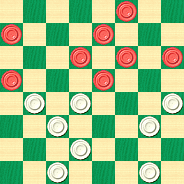
WHITE
White to Play and Win
W:W17,18,20,22,24,26,30,32:B3,5,7,10,11,12,13,15.
| 11-15 | 4- 8 | 9-13 |
| 23-18 | 25-22 | 23-18 |
| 9-14 | 8-11 | 14-23 |
| 18-11 | 27-23 | 27-18 |
| 8-15 | 11-15 | 2-7 |
| 22-18 | 31-27 | 21-17 |
| 15-22 | 7-11 | 1-5---A, 2, |
| 25-9 | 24-20 | reaching the |
| 5-14 | 6-9 | diagrammed |
| 29-25 | 28-24 | position. |
A---No draw after this. The only move is 1-6*, 26-23 (18-14, 15-18, black wins), 6-9, 32-28, 10-14, 17-10, 7-14, 24-19, 15-24, 28-19,14-17, 30-26, 17-21, 19-15, 3-8,15-10, 21-25,10-6, 25-30, 6-1, 9-14*---B, 18-9, 11-15, 1-6, 15-19, 23-16, 12-19; a draw. Wm. F. Ryan.
2---The game is still in computer book play, with 1-6 indeed being the move to draw at this point. Other plausible looking moves such as 12-16 also lose, for instance 12-16 26-23 3-8 32-28 8-12 24-19 15x24 28x19 1-5 18-14 and Black is finished.---Ed.
B---Should black bring out his king 30-25, white scores with this surprise: 30-25, 18-15!, 11-27, 1-5, 25-18, 5-32, 8-11---C, 32-27, 11-15---D, 27-31, 13-17, 26-22; white wins by First Position.
C---13-17, 32-27, 17-21, 27-23*, 21-25, 26-22, 25-30, 22-17, 30-25, 17-14, 8-11, 23-18, and white wins.
D---13-17, 27-23, 12-16 (11-15, 26-22 wins), 23-18, 16-19, 18-23, 19-24, 23-18, 24-27, 26-23, 27-31, 23-19, and white wins."
Would you flourish in this situation? Look for the solution, but don't wither; the refreshing solution can be reached by simply clicking on Read More.![]()
Sixth Position
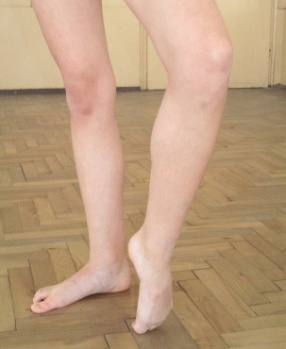
Yes, there is in fact a Sixth Position in classical ballet, going literally a step beyond the five positions known to the typical neophyte ballet student, and it's being demonstrated by our ballerina in the photo above.
In a previous Checker School installment about Second Position, we made a similar analogy to dance arts, and in making a like analogy with Sixth Position, we are just as certain as we were in our earlier installment that both ballet's standard positions and checkers' standard positions are quite unfamiliar (to say the least) to the general public.
But we would certainly never dare to lump in our loyal Checker Maven readers with the general public, so we are sure that many of you have at least some familiarity with the Sixth Position of checkers; and today, we challenge you to either demonstrate your mastery, review or relearn an old lesson, or gain new checker knowledge, all depending upon where you currently stand on the scale of checker erudition.
Here, then, is the classic Sixth Position.
A. MACKINTOSH
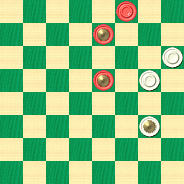
Black Plays, White Draws
B:W12,16,K24:B3,K7,K15.
Demonstrate how it's done, and when you've finished, click on Read More for the solution, sample games, and detailed notes.![]()
The Checker Maven is produced at editorial offices in Honolulu, Hawai`i, as a completely non-commercial public service from which no profit is obtained or sought. Original material is Copyright © 2004-2025 Avi Gobbler Publishing. Other material is public domain, as attributed, or licensed under Creative Commons. Information presented on this site is offered as-is, at no cost, and bears no express or implied warranty as to accuracy or usability. You agree that you use such information entirely at your own risk. No liabilities of any kind under any legal theory whatsoever are accepted. The Checker Maven is dedicated to the memory of Mr. Bob Newell, Sr.

